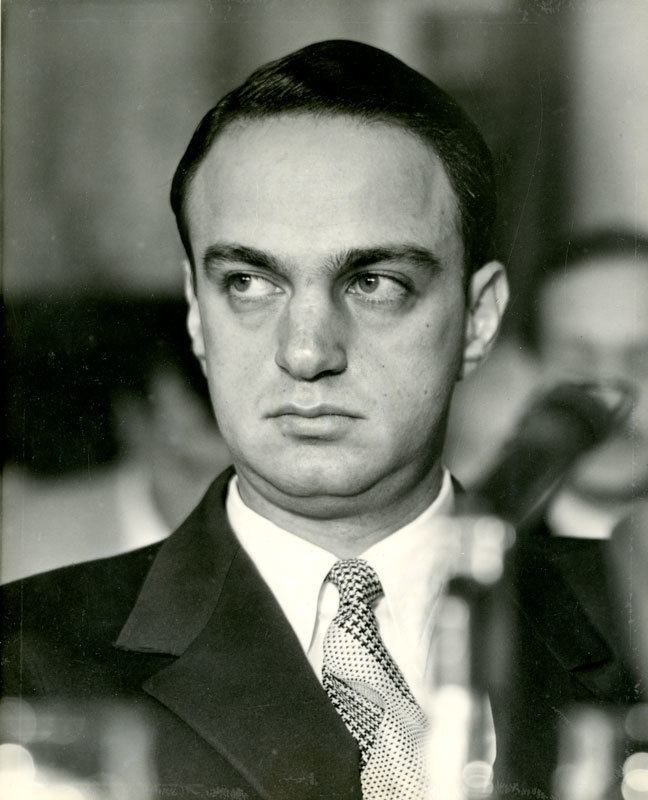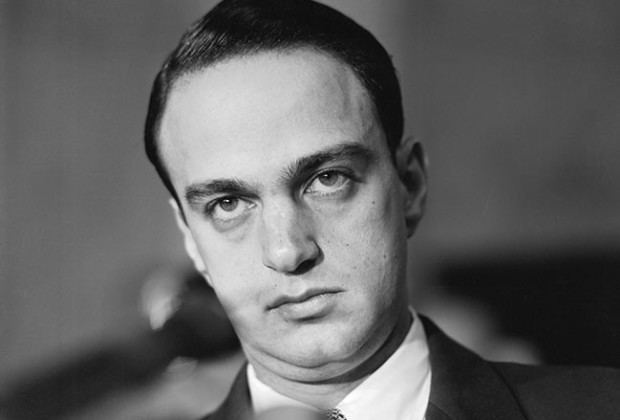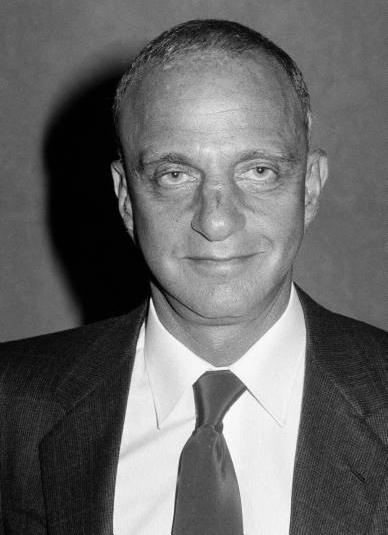Full Name Roy Marcus Cohn Role Attorney Cause of death AIDS | Occupation Lawyer Books McCarthy Name Roy Cohn | |
 | ||
Born February 20, 1927 ( 1927-02-20 ) New York City Parents Dora Marcus, Albert C. Cohn | ||
Roy cohn interview 1951
Roy Marcus Cohn (; February 20, 1927 – August 2, 1986) was an American attorney. During Senator Joseph McCarthy's investigations into Communist activity in the United States during the Second Red Scare, Cohn served as McCarthy's chief counsel and gained special prominence during the Army–McCarthy hearings.
Contents
- Roy cohn interview 1951
- What Donald Trump learned from Roy Cohn
- Early life
- Counterespionage
- Rosenberg trial
- Work with Joseph McCarthy
- Legal career in New York
- Representation of Donald Trump and Rupert Murdoch
- Later career and disbarment
- Homosexuality
- Lavender scare
- Death
- References

He was also known for being a U.S. Department of Justice prosecutor at the espionage trial of Julius and Ethel Rosenberg and later for representing Donald Trump during his early business career.

What Donald Trump learned from Roy Cohn
Early life

Born to an observant Jewish family in The Bronx, New York City, Cohn was the only child of Dora (née Marcus; 1892–1967) and Judge Albert C. Cohn (1885–1959), who was influential in Democratic Party politics. His great-uncle was Joshua Lionel Cowen, the founder and longtime owner of the Lionel Corporation, a manufacturer of toy trains. He lived in his parents' home until his mother's death, after which he lived in New York, the District of Columbia, and Greenwich, Connecticut.

After attending Horace Mann School and the Fieldston School, and completing studies at Columbia College in 1946, Cohn graduated from Columbia Law School at the age of 20. He had to wait until his 21st birthday to be admitted to the bar, and used his family connections to obtain a position in the office of United States Attorney Irving Saypol in Manhattan the day he was admitted.

Although he was registered as a Democrat, Cohn supported most of the Republican presidents of his time and Republicans in major offices across New York.
Counterespionage
As an Assistant US Attorney in Saypol's Manhattan office, Cohn helped to secure convictions in a number of well-publicized trials of accused Soviet operatives. One of the first involved the prosecution of William Remington, a former Commerce Department employee who had been accused of espionage by KGB defector Elizabeth Bentley. Although an indictment for espionage could not be secured, Remington had denied his longtime membership in the Communist Party USA on two separate occasions and was convicted of perjury in two separate trials. Cohn also prosecuted 11 members of the American Communist Party Politburo for preaching the violent overthrow of the United States government, under the Smith Act.
Rosenberg trial
Cohn played a prominent role in the 1951 espionage trial of Julius and Ethel Rosenberg. Cohn's direct examination of Ethel's brother, David Greenglass, produced testimony that was central to the Rosenbergs' conviction and subsequent execution. Greenglass testified that he had given the Rosenbergs classified documents from the Manhattan Project that had been stolen by Klaus Fuchs. Greenglass would later claim that he lied at the trial in order "to protect himself and his wife, Ruth, and that he was encouraged by the prosecution to do so." Cohn always took great pride in the Rosenberg verdict and claimed to have played an even greater part than his public role. He said in his autobiography that his own influence had led to both Chief Prosecutor Saypol and Judge Irving Kaufman being appointed to the case. He further said that Kaufman imposed the death penalty, based on his personal recommendation. If the ex parte discussions between a prosecutor and a judge outside the courtroom actually took place, they were improper.
In 2008, a co-conspirator in the case, Morton Sobell, who had served 18 years in prison, said that Julius had spied for the Soviets but that Ethel did not. However, in 2014, five historians who had published on the Rosenberg case wrote that Soviet documents show that "Ethel Rosenberg hid money and espionage paraphernalia for Julius, served as an intermediary for communications with his Soviet intelligence contacts, provided her personal evaluation of individuals Julius considered recruiting, and was present at meetings with his sources. They also demonstrate that Julius reported to the KGB that Ethel persuaded Ruth Greenglass to travel to New Mexico to recruit David as a spy."
There is a consensus among historians that Julius and Ethel Rosenberg were guilty, but their trial was marred by clear judicial and legal improprieties – many on the part of Cohn – and they should not have been executed. Distilling this consensus, Harvard law professor Alan Dershowitz wrote that the Rosenbergs were "guilty – and framed".
Work with Joseph McCarthy
The Rosenberg trial brought the 24-year-old Cohn to the attention of Federal Bureau of Investigation (FBI) director J. Edgar Hoover, who recommended him to Joseph McCarthy. McCarthy hired Cohn as his chief counsel, choosing him over Robert Kennedy, reportedly in part to avoid accusations of an anti-Semitic motivation for the investigations. Cohn assisted McCarthy's work for the Senate Permanent Subcommittee on Investigations, becoming known for his aggressive questioning of suspected Communists. Cohn preferred not to hold hearings in open forums, which went well with McCarthy's preference for holding "executive sessions" and "off-the-record" sessions away from the Capitol in order to minimize public scrutiny and to question witnesses with relative impunity. Cohn was given free rein in pursuit of many investigations, with McCarthy joining in only for the more publicized sessions.
Cohn would play a major role in assisting McCarthy's crusade against Communism. During the Lavender Scare, Cohn and McCarthy attempted to enhance anti-Communist fervor in the country by claiming that Communists overseas had convinced several closeted homosexuals employed by the US federal government to pass on important government secrets in exchange for keeping the identity of their sexuality a secret. Convinced that the employment of homosexuals was now a threat to national security, President Dwight Eisenhower signed an executive order on April 29, 1953 to ban homosexuals from obtaining jobs in the federal government.
Cohn invited his friend G. David Schine, an anti-Communist propagandist, to join McCarthy's staff as a consultant. When Schine was drafted into the US Army in 1953, Cohn made repeated and extensive efforts to procure special treatment for Schine. He contacted military officials from the Secretary of the Army down to Schine's company commander and demanded for Schine to be given light duties, extra leave, and exemption from overseas assignment. At one point, Cohn is reported to have threatened to "wreck the Army" if his demands were not met. That conflict, along with McCarthy's accusations of Communists in the defense department, led to the Army–McCarthy hearings of 1954, in which among other developments the Army charged Cohn and McCarthy with using improper pressure on Schine's behalf, and McCarthy and Cohn countercharged that the Army was holding Schine "hostage" in an attempt to squelch McCarthy's investigations into Communists in the Army. During the hearings, a photograph of Schine was introduced, and Joseph N. Welch, the Army's attorney in the hearings, accused Cohn of doctoring the image to show Schine alone with Army Secretary Robert T. Stevens.
Although the findings of the hearings blamed Cohn rather than McCarthy, they are widely considered an important element of McCarthy's disgrace. After the Army–McCarthy hearings, Cohn resigned from McCarthy's staff and went into private practice.
Legal career in New York
After leaving McCarthy, Cohn had a 30-year career as an attorney in New York City. His clients included Donald Trump, Mafia figures Tony Salerno, Carmine Galante, and John Gotti, Studio 54 owners Steve Rubell and Ian Schrager, the Roman Catholic Archdiocese of New York, Texas financier and philanthropist Shearn Moody, Jr., and the New York Yankees baseball club. He was known for his active social life, charitable giving, and combative personality. In the early 1960s he became a member of the John Birch Society and a principal figure in the Western Goals Foundation. He maintained close ties in conservative political circles, serving as an informal advisor to Richard Nixon and Ronald Reagan.
Cohn was the grandnephew of Joshua Lionel Cowen, founder of the Lionel model train company. By 1959, Cowen and his son Lawrence had become involved in a family dispute over control of the company. In October 1959, Cohn and a group of investors stepped in and gained control of the company, having bought 200,000 of the firm's 700,000 shares, which were purchased by his syndicate from the Cowens and on the open market over a three-month period prior to the takeover. Under Cohn's leadership, Lionel was plagued by declining sales, quality-control problems, and huge financial losses. In 1963, Cohn was forced to resign from the company after losing a proxy fight.
Representation of Donald Trump and Rupert Murdoch
In 1971, businessman Donald Trump moved to Manhattan, where he became involved in large construction projects. Trump came to public attention in 1973 when the Justice Department accused him of violating the Fair Housing Act in his operation of 39 buildings. The government alleged that Trump's corporation quoted different rental terms and conditions to blacks and made false "no vacancy" statements to blacks for apartments they managed in Brooklyn, Queens, and Staten Island.
Representing Trump, Cohn filed a countersuit against the government for $100 million, asserting that the charges were irresponsible and baseless. The countersuit was unsuccessful. Trump settled the charges out of court in 1975 without admitting guilt, saying he was satisfied that the agreement did not "compel the Trump organization to accept persons on welfare as tenants unless as qualified as any other tenant." The corporation was required to send a bi-weekly list of vacancies to the New York Urban League, a civil rights group, and give them priority for certain locations. Several years later (in 1978) the Trump Organization was again in court for violating terms of the 1975 settlement; Cohn called the new charges "nothing more than a rehash of complaints by a couple of planted malcontents." Trump denied the charges.
Cohn also counted Rupert Murdoch among his clients, pressuring President Ronald Reagan repeatedly in furtherance of Murdoch's interests. Cohn is credited with introducing Trump and Murdoch in the mid-1970s, marking the beginning of what was to be a deep and pivotal association between them.
Later career and disbarment
Cohn aided Roger Stone in Ronald Reagan's presidential campaign in 1979–80. Cohn helped Stone arrange for John B. Anderson to get the nomination of the Liberal Party of New York, a move that would help split the opposition to Reagan in the state. Stone said Cohn gave him a suitcase that Stone avoided opening and, as instructed by Cohn, dropped it off at the office of a lawyer influential in Liberal Party circles. Reagan carried the state with 46 percent of the vote. Speaking after the statute of limitations for bribery had expired, Stone said, "I paid his law firm. Legal fees. I don't know what he did for the money, but whatever it was, the Liberal party reached its right conclusion out of a matter of principle."
Federal investigations during the 1970s and 1980s charged Cohn three times with professional misconduct, including perjury and witness tampering. He was accused in New York of financial improprieties related to city contracts and private investments. He was acquitted of all charges. In 1986, a five-judge panel of the Appellate Division of the New York State Supreme Court disbarred Cohn for unethical and unprofessional conduct, including misappropriation of clients' funds, lying on a bar application, and pressuring a client to amend his will. In this case in 1975, Cohn entered the hospital room of a dying and comatose Lewis Rosenstiel, the multi-millionaire founder of Schenley Industries, forced a pen to his hand and lifted it to the will in an attempt to make himself and Cathy Frank—Rosenstiel's granddaughter—beneficiaries. The resulting marks were determined in court to be indecipherable and in no way a valid signature.
Homosexuality
When Cohn brought on G. David Schine as chief consultant to the McCarthy staff, speculation arose that Schine and Cohn had a sexual relationship, and when Cohn died of AIDS in 1986 the public speculation about Cohn's sexuality intensified. Although some historians have concluded the Schine–Cohn friendship was platonic, others state, based on testimony of friends, that Cohn, at least, was homosexual. During the Army–McCarthy hearings, Cohn denied having any "special interest" in Schine or being bound to him "closer than to the ordinary friend." Joseph Welch, the Army's attorney in the hearings, made an apparent reference to Cohn's homosexuality. After asking a witness if a photo entered as evidence "came from a pixie", he defined "pixie" (a camera model name at the time) for McCarthy as "a close relative of a fairy." (Fairy is a derogatory term for a homosexual man.) The people at the hearing recognized the allusion and found it amusing; Cohn later called the remark "malicious", "wicked", and "indecent."
In a 2008 article published in The New Yorker magazine Jeffrey Toobin quotes Roger Stone, "Roy was not gay. He was a man who liked having sex with men. Gays were weak, effeminate. He always seemed to have these young blond boys around. It just wasn't discussed. He was interested in power and access." Stone worked with Cohn beginning with the Reagan campaign during the Republican Party presidential primaries, 1976.
Lavender scare
Cohn and McCarthy targeted many government officials and cultural figures not only for suspected Communist sympathies, but also for alleged homosexuality. McCarthy and Cohn were responsible for the firing of scores of gay men from government employment and strong-armed many opponents into silence using rumors of their homosexuality. Former U.S. Senator Alan K. Simpson has written: "The so-called 'Red Scare' has been the main focus of most historians of that period of time. A lesser-known element ... and one that harmed far more people was the witch-hunt McCarthy and others conducted against homosexuals."
Death
In 1984, Cohn was diagnosed with AIDS and attempted to keep his condition secret while receiving experimental drug treatment. He participated in clinical trials of AZT, a drug initially synthesized to treat cancer but later developed as the first anti-HIV agent for AIDS patients. He insisted to his dying day that his disease was liver cancer. He died on August 2, 1986, in Bethesda, Maryland, of complications from AIDS, at the age of 59. According to Stone, Cohn's "absolute goal was to die completely broke and owing millions to the IRS. He succeeded in that." He was buried in Union Field Cemetery in Queens, New York.
